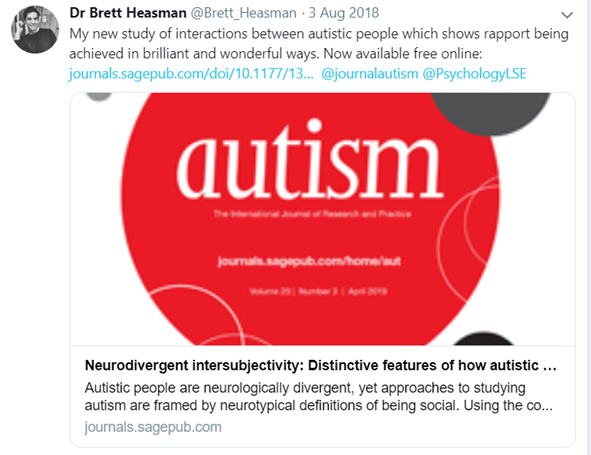From reading the article in detail, it seem mostly to do with persistence of ASC to find common language and ability to ignore, be non judgemental about false starts, keeping on trying.
The article starts with the double empathy problem - that both NT and ASC have difficulty understanding each-other:
'Studies of intersubjectivity in autism have been primarily based on autistic-to-neurotypical interactions. These have highlighted difficulties such as shared intentionality (
Tomasello et al., 2005) and reciprocating non-verbal cues (
García-Pérez et al., 2007;
Hobson and Lee, 1998). However, autistic divergence from the neurotypical norm for interacting (i.e. neurodivergent behaviour) can result in a gap in mutual understanding which makes empathy (
Milton, 2012), perspective-taking (
Heasman and Gillespie, 2017;
Sheppard et al., 2016), and social perception (
Sasson et al., 2017;
Sasson and Morrison, 2017) difficult for both parties. This two-way misunderstanding has been termed the ‘double empathy problem’ (
Milton, 2012), and it highlights the dangers of interpreting neurodivergent behaviour on neurotypical terms. Moreover, autistic interactions may be optimised differently across situations and groups'
So autistic interactions have different dynamic which involves the two findings :
Two features emerged as both potentially pervasive and consequential in explaining the patterns identified:
(1) a generous assumption of common ground and (2) a low demand for coordination [consensus].'
(1) It seems to me that the assumption of common ground implies aspie keep on
looking for common language based on shared cultural experiences. While it seem to me NT assume common language [=their language] and exclude people, if it is not reciprocated.
This is based on these sentences:
'Thus in playing with voices, players are able to develop shared language on the basis of their shared cultural resources which allows them to creatively [approach] to novel problems....a generous assumption of common ground, such as by sharing very specific voices, can lead to rapid rapport, with very closely aligned intersubjectivity.'
So if we substitute:
'sharing voices' for
'developing shared language on the basis of their shared cultural resources'
We get this:
...A generous assumption of common ground, such as by developing shared language on the basis of their shared cultural resources, can lead to rapid rapport, with very closely aligned [common understanding].
So it might be NT/ASC need to search for a common language, rather than assume it is the NT one


